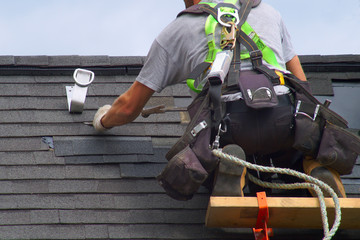What Tools Do Roofers Need?
Roofers are professionals who build, repair, and replace roofs for homes and businesses. They also analyze building plans and ensure that roofing is completed in accordance with the design. They also choose the substrates, materials, and supporting accessories for roof installations.
Residential roofers work on single-family homes. They use ladders and scaffolding to access rooftops. Roofers must be careful not to fall off of ladders, which can cause serious injuries.
Roofers professionally build, repair, and replace roofs on residential and commercial buildings. They also install insulation and vapor barriers. These professionals can also help customers choose the best roofing materials and provide estimates for their work. They are also required to follow local building codes and safety procedures. Those who are interested in becoming roofers can complete a roofing apprenticeship or take classes at a community college.
Depending on the size and scope of a project, roofers must be prepared to work with a variety of materials. They must be comfortable working at heights and should have the physical strength to lift heavy materials. In addition, they need to be able to work with hand tools and other equipment. Roofers are also responsible for preparing the job site, including removing debris and setting up ladders or scaffolding. They are also required to inspect the structure of a roof before beginning a project, and they must be able to identify problems and determine the best repair procedures.
If a roofer works for a construction company, he or she may be responsible for cleaning up and breaking down the site when the project is finished. This is especially important for jobs that involve a large amount of material. In addition, roofers must be aware of the potential dangers associated with their work and must use personal protective equipment (PPE) when working at high levels.
Roofers are also required to inspect roofs to determine the cause of leaks and other issues. In some cases, they may be required to clean and repair gutters and chimneys, remove snow or ice, and install flashing. In addition, they may need to spray walls, floors, or roofs with material to bind, seal, or insulate them.
Compared to other types of jobs, roofers are rarely required to spend long periods of time in an office environment. This makes it an ideal career for people who dislike the idea of sitting in front of a desk all day. Moreover, this type of job is often more lucrative than other types of positions because it pays well and provides an excellent opportunity for advancement.
Work environment
Roofers must be comfortable working outdoors in all types of weather. They must also be able to perform physically demanding tasks from a height, including lifting heavy materials and climbing. They often work as part of a crew, but may also be required to work alone on certain projects. Roofers are typically required to wear safety gear, such as hard hats, eye protection and long sleeves.
Many roofers specialize in a specific type of roofing, such as shingles or metal. Others focus on repairing or replacing particular kinds of roofs, such as those for commercial or residential buildings. Still other roofers focus on a particular industry, such as manufacturing, where they may be hired to waterproof foundations or floors.
The majority of roofers are employed with construction companies, but some choose to work on their own as independent contractors. Most roofers are not required to have a college degree, but must complete on-the-job training for the roofing company they work for. This can include hands-on training with the company’s roofing products as well as classroom instruction on safety protocols and regulations.
Roofers must be able to communicate effectively with other members of their roofing team, as well as with clients. They must be able to identify problems with a roof’s structure and recommend the best solution. They should also be knowledgeable about the different types of roofs, such as shingle and metal. This knowledge can help them make recommendations to clients about the best roof for their homes or businesses.
Tools
Whether they’re installing new roofs or tearing off old ones, roofers must have the right tools to do their jobs. Having the right equipment will make their job easier and more efficient, which means that they’ll be able to complete projects faster and more profitably. Here are some of the tools that every roofer needs to have:
A ladder is a must for any roofer, as it’s the only way they’ll be able to access the roof. A straight ladder will work for most jobs, but if the roof is especially steep, a platform ladder may be needed to get them up there. Roofing contractors should also have a ladder hoist to help them carry heavy items up to the roof.
Another essential tool for any roofer is a shovel. It’s great for scooping shingles and other debris into a wheelbarrow for removal or disposal. There are even specialized tear-off shovels that have teeth to help them pull up and dispose of the old roofing materials. An air knife is another specialized roofing tool that helps speed up the process by cutting through shingles quickly and easily. It does require an air compressor though to power it.
For more precise jobs, a roofer will need a tape measure. It should have a rubber overmold for a comfortable grip and a bright white tape that’s easy to read. It’s also important to have a durable pair of gloves and safety goggles for working in tricky or dangerous areas.
There are many different types of roofing nails that are used for various tasks, so it’s important for roofers to have a good supply of them. They can use a hand tacker or a pneumatic nailer to affix the underlayment, and there are even combo tools available that combine both of these for a quick and efficient roofing project. If a roofer needs to cut metal sheets, they should have a set of tin snips that allow them to make small straight or curve cuts in the material.
A good pry bar is also an essential tool for any roofer to have. There are a variety of different sizes and strengths to choose from, so they should have a few on hand for a range of applications.
Safety
Roofers must take a variety of safety measures to ensure their own and others’ safety. This includes wearing personal protective equipment (PPE), ensuring tools are in good condition and following safe work practices. It’s also important to wear sturdy footwear and avoid carrying objects that could fall and cause injuries. These precautions can help prevent falls, which are the leading cause of death in construction accidents.
While many roofing projects are relatively simple, some can be dangerous and require specialized training and equipment. Whether you’re a DIY enthusiast or a professional, following basic roof safety can help you avoid serious injury and costly mistakes.
Wearing proper PPE is the first step to safety on a roof. This includes helmets, shoes with traction and fall protection harnesses. These should be inspected regularly to ensure they’re in good working order and fit properly. Keeping the work area clean and free of debris is another important factor in roofing safety. This includes removing any nails or other sharp items that can cause falls, as well as clearing snow and leaves to improve visibility.
Falling from a roof is a common and potentially deadly hazard for construction workers. A worker may fall several stories, resulting in serious injury or even death. This is why state law requires employers to make their sites as safe as possible for workers. However, some employers fail to do so, putting workers at risk of falling several stories from a ladder or roof.
Other safety precautions include avoiding distractions while on the job and using ladders correctly. It’s important to maintain three points of contact with the ladder at all times, and never walk or climb while holding something in your hand. Ladders should be anchored securely, and workers should use a harness that attaches to a lanyard or lifeline with a self-retracting device.
Roofing contractors also protect stone and concrete walls, swimming pools, and tanks from water damage. They prepare surfaces by removing rough spots, and then spray or brush on waterproofing compounds. In addition, they seal, insulate, and soundproof sections of structures. They often use hand tools, such as hammers, knives, power fastening machines, brushes, and caulking guns.

